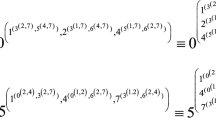Abstract
Functional constraints capture Boolean relationships among signal nets by analyzing the functionality of a circuit. Such constraints find widespread application in VLSI design methodology and can be derived using various techniques. The size and complexity of these constraints becomes a limiting factor in their successful usage for large designs. This paper describes CONAN (Constraint Analyzer), a powerful framework to analyze and simplify such constraints. CONAN is built on the solution to a novel minimization problem. The feasibility and effectiveness of CONAN is demonstrated by using it for functional untestability analysis of large industrial benchmarks. Run-times were reduced from over a week to less than 30 minutes. Additionally, unique functionally untestable faults were derived using this approach when compared with constraints provided by designers.











Similar content being viewed by others
References
Abramovici M, Breuer MA, Friedman AD (1995) Digital systems testing and testable design”. John Wiley & Sons
Agrawal VD, Chakradhar ST (Sept. 1995) Combinational ATPG theorems for identifying untestable faults in sequential circuits. IEEE Trans Comput-Aided Des 14(9):1155–1160
Bryant R (1986) Graph-based algorithms for Boolean function manipulation. Proc IEEE Trans Comput 35(8):677–691
Chen G, Reddy SM, Pomeranz I (2003) Procedures for identifying untestable and redundant transition faults in synchronous sequential circuits. Proceedings of IEEE International Conference on Computer Design, pp. 36–41
Cummins CE (1999) full_case parallel_case. the Evil Twins of Verilog Synthesis. Proc Synopsys Users Group (SNUG)
Davis M, Putnam H (1960) A computing procedure for quantification theory. J Assoc Comput Mach 7:201–215
El-Maleh A, Kassab M, Rajski J (1998) A fast sequential learning technique for real circuits with application to enhancing ATPG performance. Proc Design Autom Conference 625–631
Goldberg E, Novikov Y (2002) BerkMin: A fast and robust SAT solver. Proc Design Autom Test Europe 142–149
Goldstein H (Jun. 2002) Checking the play in Plug-and-Play. IEEE Spectrum 50–56
Hachtel GD, Somenzi F (1996) Logic Synthesis and Verification Algorithms. Springer
Heragu K, Patel J, Agrawal VD (1997) Fast identification of untestable delay faults using implications. Proc ACM/IEEE Int Conference Computer-Aided Design 642–647
Hsiao M (2002) Maximizing impossibilities for untestable fault identification. Proc Design Autom Conf 949–953
Iyer MA, Abramovici M (1996) FIRE: A fault independent combinational redundancy identification algorithm. Proc IEEE Trans Very Large Scale Integration Syst 4(2):295–301
Iyer MA, Long DE, Abramovici M (1996) Identifying sequential redundancies without search. Proc Design Autom Conference 457–462
Iyer MK, Parthasarathy G, Cheng K-T (2003) SATORI – A fast sequential sat engine for circuits. IEEE Int Conference Computer-Aided Design 320–325
Jas A, Chang Y, Chakravarty S (2006) An approach to minimizing functional constraints. Proc Int Symposium Defect Fault Tolerance VLSI Syst 215–226
Konijnenburg MH, Van Der Linden JT, Van de Goor AJ (1999) Illegal state space identification for sequential circuit test generation. IEEE Design Test Europe 741–746
Kunz W, Pradhan DK (1992) Recursive learning: An attractive alternative to the decision tree for test generation in digital circuits. Proc Int Test Conference 816–825
Larrabee T (1992) Test pattern generation using Boolean satisfiability. Proc IEEE Trans Computer Aided Design 11(1):6–22
Liang H-C, Lee CL, Chen JE (Sept. 1997) Identifying invalid states for sequential circuit test generation. IEEE Trans Computer-Aided Design Integrated Circuits Syst 16(9):1025–1033
Lin X, Pomeranz I, Reddy SM (1998) On finding undetectable and redundant faults in synchronous sequential circuits. IEEE Int Conference Comput Design 498–503
Lin Y-C, Lu F, Cheng K-T (2005) Pseudo-functional scan-based BIST for delay fault. Proc IEEE VLSI TEST Symposium 229–234
Lin Y-C, Lu F, Yang K, Cheng K-T (2005) Constraint extraction for pseudo-functional scan-based delay testing. Proc Asia South Pacific Design Autom Conference 166–171
Long DE, Iyer MA, Abramovici M (1995) Identifying sequentially untestable faults using illegal states. Proc VLSI Test Symposium 4–11
Marques-Silva JP (2000) Algebraic simplification techniques for propositional satisfiability. Proc Int Conference Principles Practice Constraint Program 537–542
Moskewicz MW, Madigan CF, Zhao Y, Zhang L, Malik S (2001) Chaff: Engineering an efficient SAT solver. Proc Design Autom Conference 530–535
Pomerantz I, Reddy SM (1994) On identifying untestable and redundant faults in synchronous sequential circuits. IEEE VLSI Test Symposium 8–14
Pomeranz I (2004) On the Generation of Scan-Based Test Sets with Reachable States for Testing Under Functional Operations Conditions. ACM/IEEE Design Autom Conference 928–933
Rearick J (2001) Too much delay fault coverage is a bad thing. Proc Int Test Conference 624–633
Schultz MH, Trishchler E, Sarfert TM (1988) SOCRATES: A highly efficient automatic test pattern generation system. IEEE Trans Computer-Aided Design 126–136
Shulz MH, Auth E (1989) ESSENTIAL: An efficient self-learning test pattern generation algorithm for sequential circuits. IEEE Int Test Conference 28–37
Silva JPM, Sakallah KA (1996) GRASP—a new search algorithm for satisfiability. Proc Int Conference Computer-Aided Design
Syal M, Hsiao MS (June 2006) New techniques for untestable fault identification in sequential circuits. Proc IEEE Trans Computer-Aided Design Integrated Circuits Syst 25(6):1117–1131
Vishakantiah P, Abraham JA, Abadir M (1992) Automatic test knowledge extraction from VHDL (ATKET). ACM/IEEE Design Autom Conference 273–278
Vlach F (1993) Simplification in a satisfiability checker for VLSI applications. Proc J Autom Reason 10(1):115–136
Zhang Z, Reddy SM, Pomeranz I (2005) On generating Pseudo-functional delay fault tests for scan designs. Proc IEEE Int Symposium Defect Fault Tolerance VLSI Syst 398–405
Zhao ZK, Rudnick EM, Patel JH (1997) Static logic implication with application to redundancy identification. IEEE VLSI Test Symposium 288–293
Author information
Authors and Affiliations
Corresponding author
Additional information
Responsible Editor: N. A. Touba
Rights and permissions
About this article
Cite this article
Jas, A., Chang, YS. & Chakravarty, S. A Methodology for Handling Complex Functional Constraints for Large Industrial Designs. J Electron Test 24, 259–269 (2008). https://doi.org/10.1007/s10836-007-5024-4
Received:
Accepted:
Published:
Issue Date:
DOI: https://doi.org/10.1007/s10836-007-5024-4




